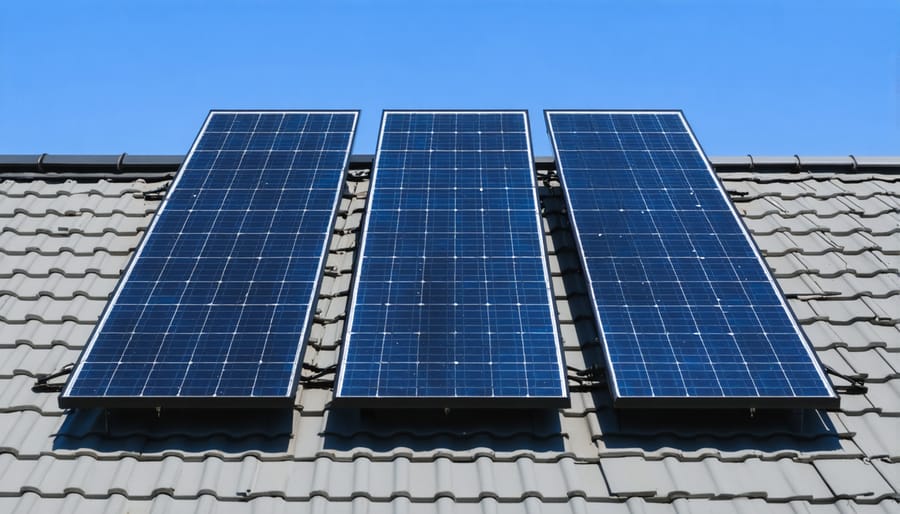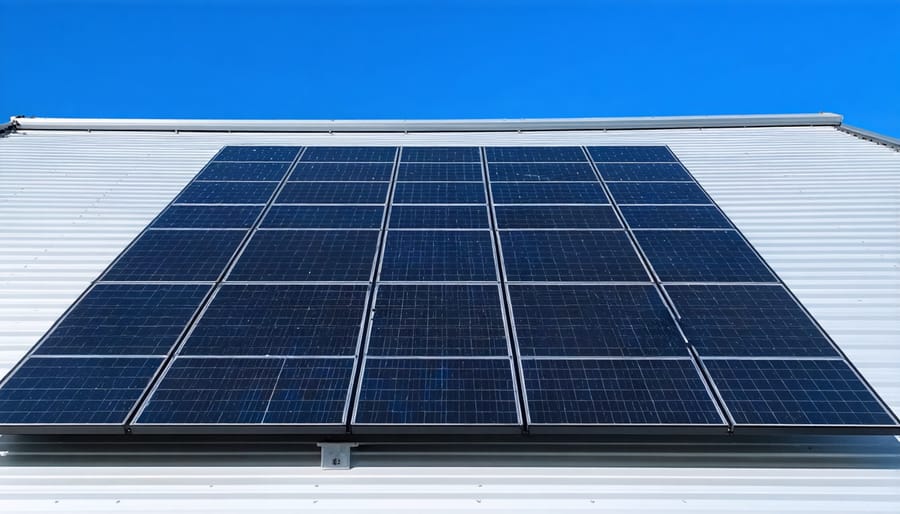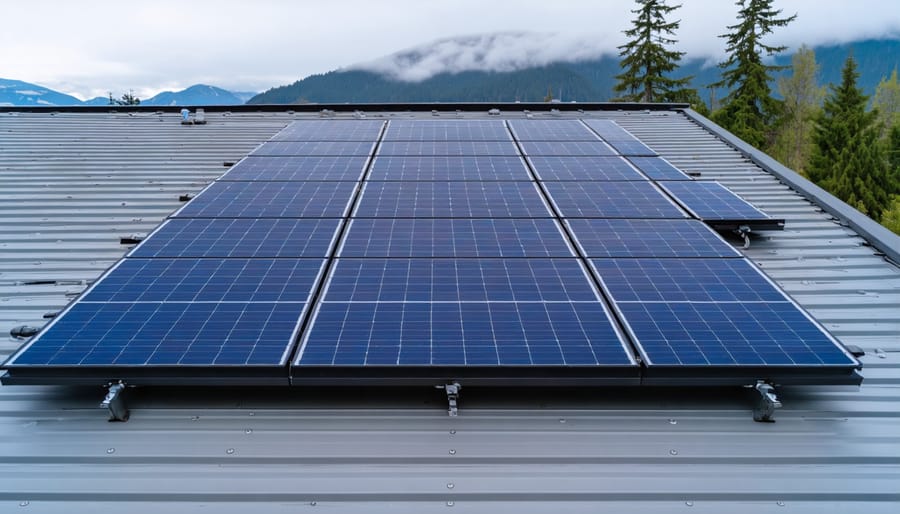Connecting three solar panels in series creates a higher voltage system that can significantly reduce energy losses across long cable runs—a practical advantage for British Columbia properties where your inverter sits far from your roof array. This configuration links the positive terminal of one panel to the negative terminal of the next, multiplying voltage while maintaining the same amperage, which means your system operates more efficiently when distance matters.
Understanding series connections becomes essential when designing your solar installation, particularly in BC’s varied weather conditions where partial shading from coastal fog or mountain terrain can impact your entire string. When you wire panels in series, the performance of your entire chain depends on the weakest panel—if one panel experiences shade or snow coverage, all three panels produce at that reduced level until conditions improve.
This setup works exceptionally well for small to medium residential installations across British Columbia, from Vancouver Island homes to Okanagan properties, where simplicity and cost-effectiveness matter. You’ll need fewer cables and connections compared to parallel configurations, reducing installation costs and potential failure points. However, the voltage increase requires careful attention to safety regulations and proper equipment ratings, making professional consultation vital before proceeding with your three-panel series system.
Understanding Series Connection: The Basics Made Simple
When you connect 3 solar panels in series, you’re essentially creating a chain where electricity flows through one panel to the next, much like water flowing through connected garden hoses. This configuration is surprisingly straightforward once you understand the basic principle.
In a series connection, the positive wire from your first panel connects to the negative wire of the second panel, and the positive from the second connects to the negative of the third. Think of it like linking batteries end-to-end in a flashlight. The key result is that while the solar panel output voltage adds up across all three panels, the current (measured in amps) stays the same as a single panel.
Here’s a practical example: If each of your panels produces 40 volts and 10 amps, connecting three in series gives you 120 volts total while maintaining 10 amps. This is different from parallel connections, where voltage stays constant but current multiplies.
Why is three panels such a popular choice? For many BC homeowners, this configuration hits a sweet spot. It provides enough voltage to work efficiently with standard inverters while keeping your system manageable in size and cost. Three panels can often fit comfortably on a garage roof or a small section of your home’s south-facing slope.
The series setup also simplifies wiring since you’re running fewer cables back to your inverter compared to parallel configurations. For residential installations across British Columbia, from Vancouver condos to Kelowna homes, this arrangement balances performance with practicality. It delivers sufficient power for partial energy offset without requiring extensive roof space or complex electrical work.

The Real Benefits of Connecting Three Panels in Series
Meeting Inverter Voltage Requirements
Most residential inverters in BC require an input voltage range between 150 and 550 volts DC to operate efficiently. Here’s where three panels in series really shine: they typically deliver voltage right in that optimal range.
Let’s look at a practical example. Standard residential solar panels produce around 30 to 40 volts each under typical operating conditions. When you connect three panels in series, you’re looking at roughly 90 to 120 volts DC—well within the startup range for most string inverters commonly used in BC homes.
Take the case of a homeowner in Kelowna who recently installed a system with three 400-watt panels in series. Their configuration produces about 105 volts DC, perfectly matching their inverter’s requirements without wasting energy or risking equipment damage from voltage mismatches.
This sweet spot matters because voltage too low means your inverter won’t start, while voltage too high can damage equipment or require expensive safety measures. Three panels often eliminate the guesswork, making it a reliable starting point for residential installations across BC’s diverse climate zones. Your certified installer will verify compatibility with your specific inverter model, ensuring your system operates safely and efficiently from day one.
Simpler Wiring, Lower Installation Costs
When you connect 3 solar panels in series, you’re making a smart choice that can significantly reduce both the complexity of your installation and the associated costs. Here’s why this matters for your solar project in British Columbia.
Series wiring uses a single cable run that links your three panels together in a chain: positive to negative, panel to panel. Compare this to a parallel setup, where each panel requires separate wiring back to a combiner box or inverter. Fewer cables mean less material cost and dramatically reduced installation time for your solar installer.
The cost savings are tangible. A typical series connection might require only 30-40 meters of cable for three panels, while a parallel configuration could need 60-80 meters or more, depending on your roof layout. With quality solar cable costing between 2 to 4 dollars per meter in BC, you’re looking at potential savings of 60 to 160 dollars just on materials for three panels. Installation labor adds further savings, since electricians can complete series connections in roughly half the time of parallel setups.
For a residential installation in Kelowna last year, a homeowner saved approximately 400 dollars on their three-panel system by choosing series wiring, money they redirected toward monitoring equipment. This streamlined approach also means fewer connection points where potential issues could develop over time, improving long-term reliability.
The simplicity extends to troubleshooting too. With one continuous circuit, your installer can quickly identify and resolve any issues that might arise during installation or maintenance visits.
Critical Installation Considerations for BC Climate
The Shading Problem You Can’t Ignore
When you connect 3 solar panels in series, you create a powerful string that works together—but there’s an important catch. If even one panel gets shaded, it affects the performance of all three panels in the chain. Think of it like water flowing through a garden hose: a kink in one spot slows down the entire flow.
This is especially relevant for BC homeowners. Our beautiful forested landscapes and frequent cloud cover mean partial shading is more common than in sunnier regions. A tree branch casting shade on just one panel can reduce your entire string’s output by 60% or more during those hours.
Here’s what happens: in a series connection, electricity flows through each panel sequentially. The shaded panel produces less current, and since all panels in the series must carry the same current, the entire string drops to match the weakest performer. A local Nanaimo family discovered this firsthand when morning shade from a cedar tree cut their system’s early-day output significantly.
The good news? Modern solar panels come equipped with bypass diodes, which are built-in safety features that help minimize shading losses. These clever devices allow electricity to route around shaded cells, reducing the impact on your overall production. When planning your installation, discuss panel placement carefully with your installer to avoid known shade patterns. Some homeowners in Victoria’s older neighborhoods have successfully trimmed select branches or adjusted panel angles to maximize sun exposure year-round.
Understanding shading effects helps you make smarter placement decisions and set realistic expectations for your system’s performance.
Snow and Weather Impact on Series Configurations
British Columbia’s winter weather presents unique considerations for solar panels connected in series. Understanding these challenges helps you maintain optimal performance year-round while protecting your investment.
Snow accumulation poses the primary winter challenge for series configurations. When snow covers even one panel in your three-panel series setup, it can significantly reduce the entire system’s output since the current must flow through all panels equally. Unlike BC’s cloudy conditions, which still allow some light penetration, heavy snow creates a complete barrier. However, BC’s relatively mild coastal winters mean snow typically melts faster than in other Canadian regions.
To maintain performance during winter months, consider these practical strategies. Install panels at a steeper tilt angle (45-50 degrees) to encourage natural snow shedding. This works particularly well in Interior BC communities like Kelowna and Kamloops. Position panels where they receive maximum southern exposure and morning sun, accelerating snow melt. Many BC homeowners report that dark panel surfaces generate enough heat to clear light snow within hours of sunshine.
For persistent snow coverage, use a soft-bristled roof rake designed specifically for solar panels. Never use metal tools or harsh scraping methods that could damage panel surfaces or electrical connections. A local success story comes from a Squamish business owner who installed heating cables along panel edges, ensuring consistent winter performance without manual clearing.
Regular monitoring through your inverter’s app helps you identify snow-related performance drops quickly, allowing timely intervention when needed.

Safety and Electrical Standards in British Columbia
When connecting 3 solar panels in series, understanding voltage safety and BC’s electrical standards is essential for protecting both your investment and your property. In British Columbia, solar installations must comply with the Canadian Electrical Code (CEC) and local electrical regulations, which set strict requirements for system voltage, grounding, and protective equipment.
A series connection of 3 standard residential solar panels typically produces between 90 and 135 volts DC under normal conditions. While this voltage level is generally within safe operational ranges, it requires proper handling and installation techniques. Under certain conditions like cold, bright winter days in BC’s interior regions, voltage can spike higher, making professional installation critical for safety.
BC’s electrical code mandates that solar systems include appropriate disconnect switches, proper conductor sizing, and adequate overcurrent protection. These safety measures prevent electrical fires, equipment damage, and potential harm to installers or homeowners. The regulations also require that systems be installed by or inspected by qualified professionals who understand how series configurations affect overall system voltage.
Working with certified solar installers ensures your 3-panel series system meets all provincial requirements and passes necessary electrical inspections. Certified professionals understand how to properly size conductors for higher DC voltages, select appropriate inverters rated for your series voltage, and implement proper grounding systems that protect against lightning strikes and electrical faults.
A Surrey homeowner who attempted a DIY installation learned this lesson firsthand when their system failed inspection due to improper grounding. After hiring a certified installer to correct the issues, they discovered the additional cost exceeded what professional installation would have been initially, while also delaying their solar savings by several months.
When Three Panels in Series Makes Sense for Your Property
Deciding whether three panels in series works for your property comes down to matching your specific circumstances with what this configuration delivers best. Let’s walk through the key factors that make this setup a smart choice for many BC homeowners and businesses.
Start by evaluating your available roof space. If you have a compact, unshaded area that receives consistent sunlight—perhaps a south-facing garage roof or a small section of your main roof—three panels in series can maximize energy production without spreading equipment across multiple locations. This configuration works particularly well when you’re dealing with limited installation areas but still want meaningful power generation.
Your energy needs matter significantly. Three panels typically generate between 900-1,500 watts, which suits properties with moderate electricity consumption. Consider a small cabin in the Okanagan that recently installed this setup: the homeowner powers essential appliances, lighting, and a home office, reducing grid dependence by approximately 30 percent. If your monthly electricity bills fall within the $80-150 range, this configuration often provides an excellent entry point.
Roof orientation plays a crucial role in BC’s varied climate. Properties with south or southwest-facing roofs capture optimal sunlight throughout the year, making series connections more efficient. However, if your roof faces multiple directions or has partial shading from nearby trees, you might need additional equipment like optimizers to maintain performance.
Think about scalability too. Starting with three panels in series gives you flexibility to expand later. A Kelowna café began with this modest setup and added two more series strings within eighteen months as their business grew, demonstrating how this configuration supports gradual investment.
Budget considerations also influence this decision. Three panels represent a manageable upfront cost—typically $3,000-5,000 including installation—making solar accessible without requiring major financial commitments. This approach lets you experience solar benefits while testing system performance before expanding further.
If these factors align with your situation, three panels in series offers a practical pathway into renewable energy that balances cost, space, and production effectively.
Local Success Story: A Vancouver Island Installation
When Sarah Chen decided to add solar power to her coffee roastery in Courtenay, she faced a common Vancouver Island challenge: limited roof space on her heritage building. After consulting with a certified installer, she opted for a three-panel series configuration using high-efficiency 400-watt modules.
The decision wasn’t without initial concerns. Sarah worried about the island’s frequent cloudy weather and whether just three panels could make a meaningful difference to her business’s energy costs. Her installer explained that connecting the panels in series would boost voltage to 115V, perfectly matching her grid-tie inverter’s requirements while maintaining efficiency even during overcast conditions.
The installation took just one afternoon in March 2023. The biggest challenge came from ensuring proper mounting on the older roof structure, which required additional reinforcement to meet BC Building Code standards. The total investment, including the structural work, came to $3,200 before provincial and federal incentives reduced her out-of-pocket cost to $2,100.
After one year of operation, Sarah’s results exceeded expectations. The three-panel system generates approximately 1,400 kWh annually, covering nearly 30 percent of her roastery’s daytime energy needs. On sunny summer days, her meter actually runs backward, earning credits through BC Hydro’s net metering program.
The most surprising benefit? Customer response. Sarah mounted a small display showing real-time solar production, which became a conversation starter. Several customers have since asked for her installer’s contact information, inspired by seeing solar work effectively in a practical business setting.
Her advice for others considering a small series configuration: start with quality panels, work only with certified professionals familiar with BC’s specific requirements, and don’t underestimate what even three panels can accomplish in the right application.

Next Steps: Finding the Right Installer in BC
Finding the right installer is crucial for a successful solar project, especially when dealing with series configurations. Start by connecting with certified solar professionals through Solar BC’s network of qualified installers who understand local conditions and regulations.
When interviewing potential installers, ask specific questions about series configurations. How will they design the system to handle BC’s variable weather? What string inverter or optimizer options do they recommend for your roof layout? Request examples of similar installations they’ve completed in your area and ask about their experience with shade management solutions.
A reputable installer will conduct a thorough site assessment, examining your roof’s orientation, shading patterns throughout the year, and electrical system capacity. They should provide detailed proposals comparing different configuration options, including the pros and cons of series versus parallel arrangements or hybrid systems with optimizers.
Before making final decisions, take advantage of Solar BC’s tools for calculating potential savings based on your specific location and energy usage. These resources help you understand the financial return of your investment and compare installer proposals objectively.
Don’t hesitate to request multiple quotes and ask for references from past customers. Check that your chosen installer holds proper licensing, insurance, and manufacturer certifications. Many BC installers also offer monitoring services to track your system’s performance over time, ensuring your three-panel series configuration delivers optimal results for years to come.
Connecting three solar panels in series can be an excellent solution for specific energy needs in British Columbia, particularly when you’re working with limited roof space or need higher voltage output for certain inverter systems. This configuration works best for smaller installations like cabins, workshops, or supplemental power systems where modest energy generation meets your goals without the complexity of larger arrays.
The key to success lies in understanding your unique situation. Three panels in series offer simplicity and cost-effectiveness, but they also come with limitations around shading sensitivity and total power output. Before moving forward, consider your daily energy consumption, available sunlight hours throughout BC’s varied seasons, and whether your roof receives consistent, unobstructed sun exposure.
Taking the next step is straightforward. Reach out to certified solar installers in British Columbia who understand our local climate conditions, building codes, and available incentives. A professional assessment will reveal whether three panels in series align with your energy goals or if alternative configurations better suit your property. Many BC homeowners and businesses have successfully started their solar journey with modest systems, later expanding as their confidence and needs grow. Your sustainable energy future begins with informed decisions tailored to your specific circumstances.

